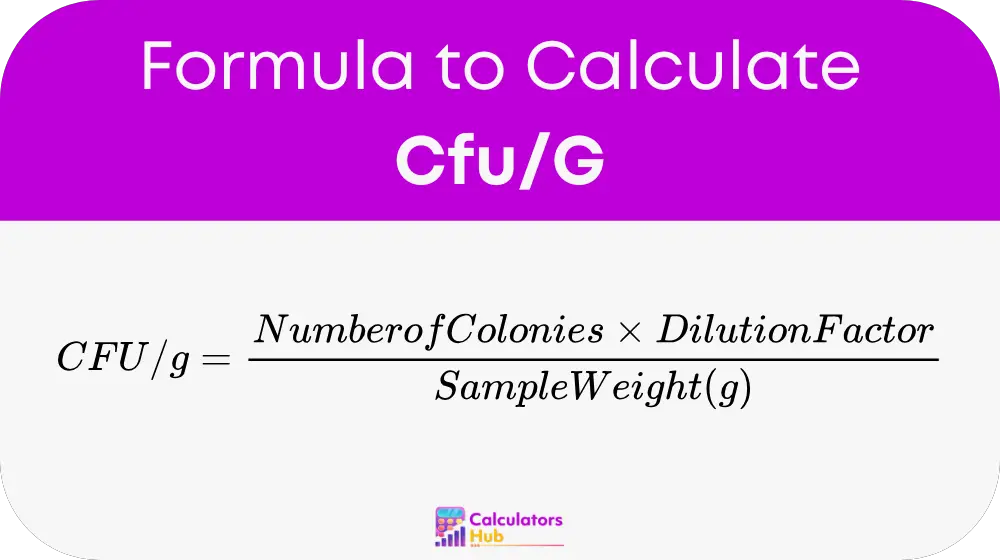The CFU/G Calculator is an essential tool in microbiology for calculating the number of Colony-Forming Units (CFUs) per gram of a sample. This unit is widely used in the food, water, and pharmaceutical industries to quantify microbial contamination. It provides valuable data for quality control, ensuring that products meet safety standards and that contamination is within acceptable limits.
In microbiological testing, a sample is usually diluted, plated on an agar plate, and incubated to allow the growth of microbial colonies. The CFU/g value represents the number of viable microorganisms in a sample per gram of material. It is an essential measure in various fields, including clinical diagnostics, food safety, environmental monitoring, and research.
Formula of Cfu/G Calculator
The formula for calculating CFU/g is:

Where:
- CFU/g = Colony-Forming Units per gram of the sample.
- Number of Colonies = The number of microbial colonies observed on the agar plate after incubation.
- Dilution Factor = The factor by which the sample was diluted before plating (e.g., if the sample is diluted 1:10, the dilution factor is 10).
- Sample Weight (g) = The weight of the sample in grams, which was used to prepare the microbial suspension.
This formula is used to calculate the number of viable microorganisms in a given sample based on the observed growth on the agar plate, taking into account the dilution of the sample and its weight.
General Terms for Quick Reference
To help streamline the process and assist users in making quick calculations without repeated conversions, here is a table for general terms that are often search or needed during microbial counting:
| Term | Definition |
|---|---|
| Colony-Forming Unit (CFU) | A unit used to estimate the number of viable microorganisms in a sample. |
| Dilution Factor | The ratio by which the original sample was diluted before plating. |
| Sample Weight (g) | The weight of the sample in grams used to prepare the microbial solution. |
| Agar Plate | A petri dish used to culture and count colonies of microorganisms. |
This table helps simplify the key terms involved in CFU/g calculations, making it easier for users to understand the process and requirements.
Example of Cfu/G Calculator
Let's walk through an example of how to use the CFU/G Calculator:
Given:
- Number of Colonies = 150 (counted on the agar plate)
- Dilution Factor = 100 (1:100 dilution)
- Sample Weight = 10 grams (the weight of the sample taken for the test)
Step 1: Apply the formula
CFU/g = (Number of Colonies * Dilution Factor) / Sample Weight
CFU/g = (150 * 100) / 10
Step 2: Perform the calculation
CFU/g = 15000 / 10
CFU/g = 1500
So, the result is 1500 CFU/g, meaning there are 1500 viable microbial units per gram of the sample.
This example demonstrates how straightforward it is to use the CFU/G Calculator by applying the basic formula.
Most Common FAQs
CFU/g is crucial for understanding the microbial load in a sample. It helps ensure that products are free from harmful microorganisms and meet the required safety standards. In industries like food safety, pharmaceuticals, and environmental testing, knowing the CFU/g allows experts to evaluate the level of contamination and decide on the necessary treatment or control measures.
When dealing with very low CFU/g values, it is important to ensure proper dilution techniques and careful counting. If colonies are too few to count, higher dilution factors may need to be apply. Additionally, using sensitive detection methods, such as selective agar media or molecular techniques, can help improve the accuracy of counting.
Yes, the CFU/g formula can be apply to any sample type, whether it’s food, water, soil, or clinical samples. However, the preparation and handling of the sample may vary depending on the material, so it's important to follow standard protocols for microbial testing in each case.